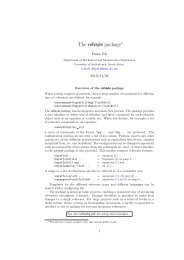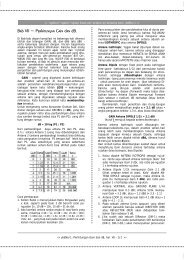Create successful ePaper yourself
Turn your PDF publications into a flip-book with our unique Google optimized e-Paper software.
It is possible to take the screen voltage from a low voltage supply,<br />
frequently using an already available source in the equipment.<br />
There is considerable latitude so that an available voltage can<br />
be used. Sometimes a combination might be employed, where<br />
a dropping resistor is used in conjunction with a low voltage or<br />
intermediate voltage supply. Frequently a combination of series<br />
resistor and voltage source can be chosen so that the rated screen<br />
dissipation will not be exceeded regardless of the variations in<br />
screen current. With a fixed screen supply, there are advantages<br />
in using an appreciable amount of fixed grid bias so as to provide<br />
protection against loss of excitation, or for cases where the driver<br />
stage is being keyed.<br />
If the screen voltage is taken through a dropping resistor from the<br />
anode supply, there is usually little point in using a fixed grid bias<br />
because an unreasonable amount of bias would be required to<br />
protect the tube if the excitation failed. When a screen dropping<br />
resistor is used, most of the bias is normally supplied through a grid<br />
resistor and other means are used for tube protection.<br />
Under operating conditions with normal screen voltage, the cutoff<br />
bias is low (screen voltage divided by the screen µ ). When a<br />
stage loses excitation and runs statically, the screen current falls<br />
close to zero. (See static curves of tube in question.) If the screen<br />
voltage is obtained through a simple dropping resistor from the<br />
anode supply, the screen voltage will then rise close to full anode<br />
voltage. Because the cutoff bias required is proportional to the<br />
screen voltage, the grid bias required will be much greater than the<br />
amount of bias desired under normal operating conditions.<br />
The power output from a tetrode or pentode is very sensitive to<br />
screen voltage. For this reason, any application requiring a high<br />
degree of linearity through the amplifier requires a well regulated<br />
screen power suppy. A screen ropping resistor from the anode<br />
supply is not recommended in such applications.<br />
The suppressor grid power supply requirements are quite similar to<br />
the control grid power supply. The suppressor grid intercepts very<br />
little current, and therefore a low power supply may be used. Any<br />
variation in suppressor voltage due to ripple or lack of regulation<br />
will appear in the output of the amplifier due to the suppressor grid<br />
modulation of the anode current.<br />
68
















